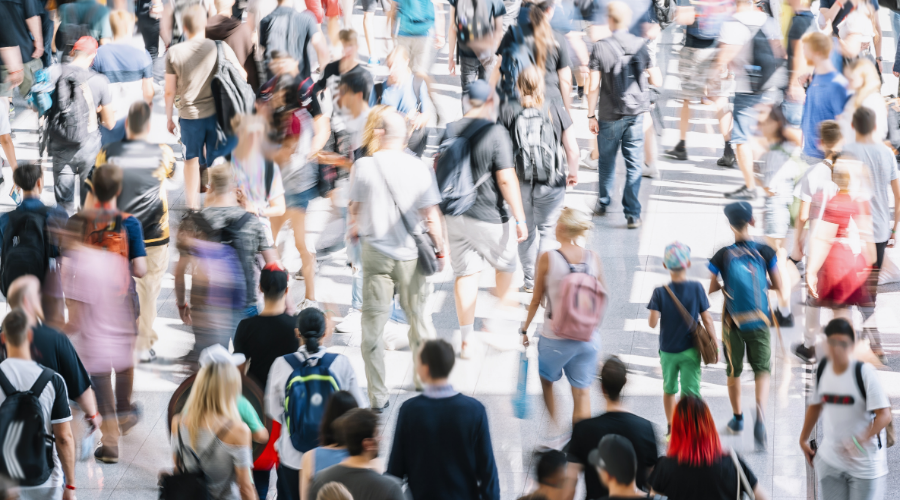Airports are Re-opening and Preparing for Crowds with Video Analytics

With Post COVID Travel Resurgence, Waiting Times are Increasing
A recent article in the BBC News describes the queues at Heathrow Airport as “untenable,” with wait times of up to six hours, due to additional checks related to COVID 19 and curbing the virus spread. Of course, queues are detrimental to the traveler experience at the best of times, but – especially with the increased need for physical and social distancing – crowds and queues pose an even more significant risk during the pandemic. And, as many countries and their aviation and tourism industries look to reopening amid vaccinations efforts, the extensive wait times and uncontrollable queues and crowds are cause for concern: The prospect of travel picking up, while welcome, also means more congestion in an environment where bottlenecks are already “untenable.”
Now more than ever, airports and other transportation hubs, need to be considering smart solutions to reduce crowding, control queues and rapidly respond to expected and unanticipated traffic peaks. This is critical, of course, for the traveler experience – which is always top of mind – but also for health and safety, security, and operational efficiencies across air, rail, and ground transportation hubs.
Realizing the Value of Video Analytics for Queue Control
The transportation industry has long relied on video surveillance for safety and security, live monitoring and perimeter protection, as well as post-event investigation. Today, many airports and transit hubs are extending these systems with complementary video content analytics software for deriving operational intelligence, increasing situational awareness, and driving safety, security, efficiency, as well as traveler experiences. Occupancy, crowd, and queue control are critical to all of these efforts and one area where video analysis technology can provide invaluable support and extend the utility of video surveillance investments.
Powered by Deep Learning and artificial intelligence (AI), video analytics can detect, extract, and classify objects in video, as well as track or “count” the number of objects that are in a camera view or have passed through a pre-defined area. Management teams can leverage video analysis on-demand and in real time, to assess trends and patterns or respond to situational changes in the environment.
Tracking Crowd & Queues to Drive Intelligent Decision-Making
For many airport decision makers, planning is based on incomplete data and observation-based guesswork of how visitors are interacting with and navigating through different areas and terminals. Video analysis captures the occupancy and activity trends within an airport, by visualizing intelligence in dashboards, heatmaps, and charts. Managers can understand occupancy and crowding rates for different areas at different times of day, identify problem hotspots where bottlenecks occur, and pinpoint unexpected peak times, in order to develop solutions to combat crowds and queues at parking lots, check-in stations, security checkpoints, and baggage claims. The data can even be used to guide strategy about restaurant or retail tenants within terminals and demonstrate to potential tenants the value of different properties. It can also be used for maximizing efficiencies around maintenance and cleaning, by planning cleaning schedules based on facility usage and the areas that are most heavily trafficked.
Armed with better intelligence, airport managers can direct staffing, signage, and even distribution of services within different terminals to accommodate known trends, prevent crowding, and plan for contingencies and peak travel days.
Detecting & Reacting to Queue & Crowd Formations in Real-Time
To maintain safe terminal occupancy rates, proactively disperse crowds, and streamline airport navigation, airports can use real-time, video analysis-driven alerting to detect crowds and queues as they form. Alert notifications can be configured based on known trends and pre-determined conditions, so that operators can be quickly informed when a crowd is forming and take action to prevent bottlenecks, dense crowding, and long queues.
Whether to drive better traveler experiences through reduced queue waiting times; increase operational efficiencies around maintenance and cleaning as well as terminal staffing; promote public health and safety during the pandemic and beyond; or to drive long-term decision making and strategy around airport optimizations, video analysis is powerful tool in the re-opening airport’s arsenal. As airports look hopefully to the summer season, “untenable” queues and growing crowds are a real concern – but one that can be overcome with smart technology investments and better insight into environmental trends and situational changes
Signup to receive a monthly blog digest.